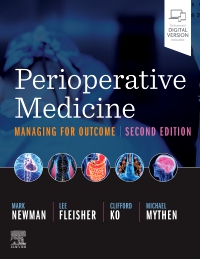
Perioperative Medicine Elsevier eBook on VitalSource, 2nd Edition
Elsevier eBook on VitalSource

-
- Focuses on what anesthesiologists, surgeons, and intensivists need to know in order to improve outcomes through evidence- and outcome-based approaches.
- Provides practical guidance on potential risks to all major organ systems, the etiology of particular organ dysfunctions, preoperative and intraoperative risk factors, and perioperative protection strategies to minimize potential complications.
- Features a consistent chapter format - with even more color-coded algorithms, summary tables, and boxes – that enables you to quickly explore and determine the best management approaches.
- Includes six all-new chapters: Perioperative Fluid Management; Delirium and POCD; Role of Palliative Care/ICU; Value-Based Care: The UK Model; CFO Perspective on Value; Hospital to Home (Perioperative Transitions of Care)
- Discusses timely topics such as quality improvement, pay-for-performance, preexisting disease and comorbid conditions in anesthesiology, and the team-based model of care.
- Features two new editors, surgeon Clifford Ko, MD, and Perioperative Summit leader, Michael (Monty) Mythen, MD.
- Enhanced eBook version included with purchase. Your enhanced eBook allows you to access all of the text, figures, and references from the book on a variety of devices.
-
Part I: INTRODUCTION AND BACKGROUND
1. Implications of Perioperative Morbidity for Long-Term Outcomes 2. The Inflammatory Response to Surgery 3. The Coagulation Cascade in Perioperative Organ Injury
Part II: PREOPERATIVE ASSESSMENT
4. The Value of Preoperative Assessment 5. Perioperative Cardiac Risk Assessment in Noncardiac Surgery 6. Cardiovascular Risk Assessment in Cardiac Surgery 7. Central Nervous System Risk Assessment: Preventing Postoperative Brain Injury 8. Risk Assessment and Perioperative Renal Dysfunction 9. Pulmonary Risk Assessment 10. Hematologic Risk Assessment
Part III: PRESERVATION OF ORGAN FUNCTION AND PREVENTION AND MANAGEMENT OF PERIOPERATIVE ORGAN DYSFUNCTION
SECTION 1 Cardiovascular System 11. Prevention of Ischemic Injury in Cardiac Surgery 12. Prevention of Ischemic Injury in Noncardiac Surgery 13. Treatment of Perioperative Ischemia, Infarction, and Ventricular Failure in Cardiac Surgery 14. Perioperative Management of Valvular Heart Disease 15. Prevention and Management of Perioperative Dysrhythmias
SECTION 2 Renal System 16. Perioperative Fluid Management 17. Preservation of Renal Function 18. Evaluation and Treatment of Acute Oliguria 19. Perioperative Management of Renal Failure and Renal Transplant
SECTION 3 Pulmonary System 20. Prevention and Treatment of Postoperative Pulmonary Complications
SECTION 4 Central Nervous System 21. Carotid and Intracranial Surgery 22. Protecting the Central Nervous System During Cardiac Surgery 23. Preservation of Spinal Cord Function 24. Perioperative Management of Acute Central Nervous System Injury
SECTION 5 Gastrointestinal System 25. Prevention and Treatment of Gastrointestinal Morbidity
SECTION 6 Hematology and Coagulation 26. Prevention and Management of Deep Vein Thrombosis and Pulmonary Embolism 27. Perioperative Management of Bleeding and Transfusion
SECTION 7 Infections 28. Prevention of Perioperative Surgical Site Infection 29. Perioperative Protection of the Pregnant Woman 30. Preservation of Fetal Viability During Noncardiac Surgery
Part IV EARLY POSTOPERATIVE CARE
SECTION 9 Specific Operations 31. Cardiac Surgery 32. General Thoracic Surgery 33. Major Abdominal Surgery 34. Major Orthopedic Surgery 35. Solid Organ Transplantation 36. Multisystem Trauma 37. Neurosurgery
SECTION 10 Specific Problems 38. Sepsis and Septic Shock 39. Acute Respiratory Failure 40. Endocrine and Electrolyte Disorders 41. Improving Pain and Outcomes in the Perioperative Setting 42. Postoperative Cognitive Dysfunction and Delirium 43. Role of Palliative Care
Part V CONFLICTING OUTCOMES VALUE BASED CARE
44. Economic Analysis of Perioperative Optimization 45. Improving Health-Care Quality Through Measurement 46. Delivering Value Based Care: The UK Perspective 47. Transitions From Hospital to Home